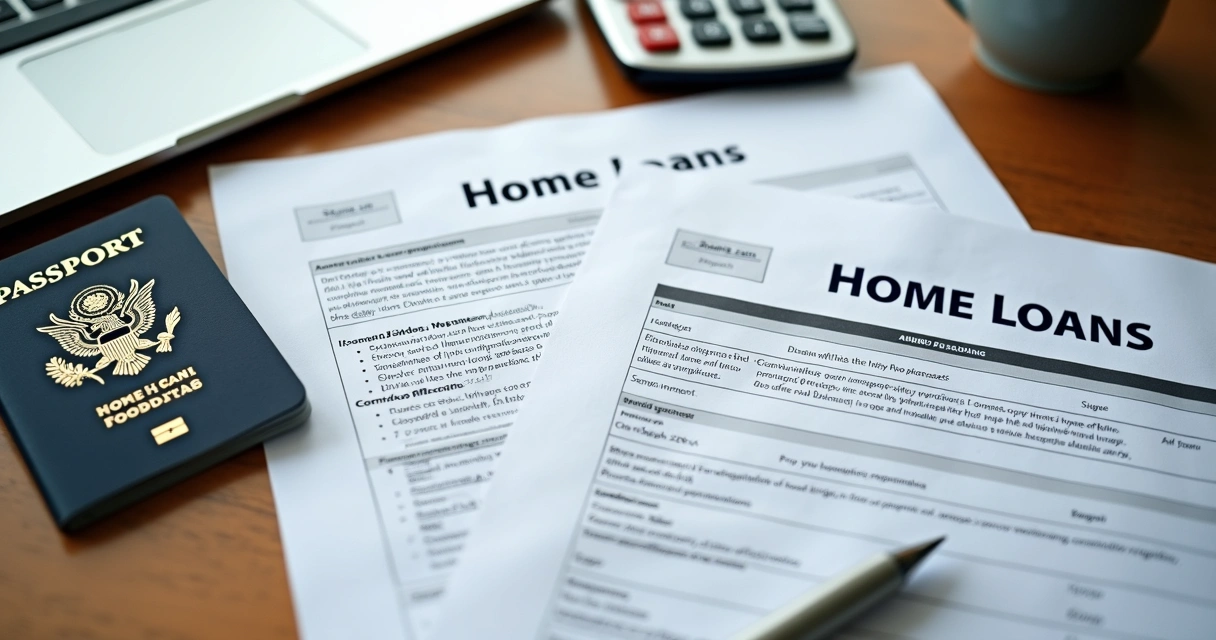When I first started studying how people from outside the United States could buy property there, what struck me most was how broad the rules and options could be. Applying for a mortgage as a non-resident is not impossible; in fact, it's far more routine than newcomers might think. Yet, the journey is unlike the standard process citizens or green card holders know. Each status, each path, brings its own turns.
I want to bring some clarity to this path. In this guide, I’ll map out US mortgage options for people without permanent resident status, touching on eligibility, required papers, types of loans, key pitfalls, and legal points. My own observations, gathered from assisting numerous buyers from many backgrounds, are scattered throughout.
Understanding residency status and its impact
The very first thing lenders look at is your residency classification. This matters because it affects not only the range of mortgage choices but also the paperwork you'll need, and sometimes even your down payment.
- Permanent Residents (Green Card Holders): Treated almost like US citizens. Access to standard loan programs is common.
- Temporary Residents (visa holders - E, H, L, TN, etc.): Eligible for many conventional options, but rules vary for government-backed loans.
- Non-Resident Aliens (no US residence, with foreign passport): A more limited range of choices, but still possible, especially through special "foreign national" mortgages.
- DACA, asylum seekers, refugees: Unique rules apply. Some mainstream loans are possible (like FHA after recent HUD changes), but expect close document scrutiny.
The main point is simple, though: Not having a green card or citizenship does not automatically exclude you from borrowing to buy property in the United States.
Residency status shapes your mortgage path, but doesn't close the door.
If you want a deeper breakdown on these categories and how they affect mortgage eligibility, I suggest checking out the complete guide to financing property without a green card. I've found it very helpful for clarifying who's eligible for which loan types.
Types of loans available to non-residents
I still remember the surprise on a client's face when she learned that, as a non-citizen, she could pick from several US home loan categories. Here’s my breakdown, based on years of experience:
Conventional loans
The most common US home financing comes from banks and lending institutions, underwritten to so-called 'conventional' standards. Many lenders are open to temporary residents with a valid visa, work authorization, SSN or ITIN, proof of income, and an established US credit record.
- Usually requires a higher down payment (20-30% for non-permanent residents)
- FICO credit score, US-taxed income, and employment verification are typical requirements
- Some lenders relax requirements for documented high-net-worth applicants
FHA, VA, and USDA loans
The US government backs certain mortgage products (FHA, VA, USDA), and their rules draw clear lines are around residency:
- FHA Loans: Available to permanent and some temporary residents, including certain visa holders (per HUD guidelines). Requires a valid SSN and legal residency proof. Down payments as low as 3.5% for well-qualified buyers.
- VA Loans: Reserved for US military (and their eligible spouses/certain groups) only.
- USDA Loans: Also open to non-citizen permanent residents; targeted to rural property, strict income limits apply.
For more on HUD’s recent policy clarifying FHA eligibility for temporary residents, the non-citizen mortgage eligibility update is a reliable resource.
Foreign national mortgages
This category was made to address the very real reality: some buyers live and work entirely abroad but want to hold US property as an investment, vacation home, or for their US-based family.
- No US credit required, but expect larger down payments (20%-40% or more common).
- Proof of foreign income, translated and sometimes certified, is a must.
- Slightly higher rates and more fees, reflecting additional lender risk.
- Not typically eligible for government insurance (FHA, VA, USDA).
If you want to see the exact steps for this path, a practical guide to foreign national mortgages is directly on target.
ITIN mortgages
Some lenders also serve buyers with only an ITIN (Individual Taxpayer Identification Number), rather than a Social Security Number. It’s a specialized category:
- Available to those filing US tax returns under an ITIN (often non-residents or residents without SSN)
- Down payments of 15-30% common
- Alternative credit accepted (rent payment history, utility bills, etc.)
- Rates higher than typical conventional, but often competitive in current markets
I recently walked a client through this process, and the ITIN mortgage step-by-step resource was vital for demystifying each requirement.
The role of documentation and credit
Getting approved for a US mortgage as a non-resident always comes down to how well you show your identity, your income, and your credit reputation. I can’t stress enough how much paperwork you’ll need, but a tidy (and verified) stack of documents can open many doors.
 What you typically need
What you typically need
- Passport and visa information
- Proof of legal US entry/status (I-94, ESTA, or visa page stamps)
- Two years of income proof (foreign tax returns, employer letters, pay stubs)
- US or foreign bank statements, usually covering recent 2-6 months
- Proof of down payment source and “seasoning” in a bank account
- Credit report: US credit bureau, or a foreign equivalent, sometimes backed by alternative references
- Contact information for foreign and US addresses, if applicable
Some lenders will accept accountant or bank letters from abroad to document income, but they should be notarized and, if not in English, professionally translated. It’s a step many overlook until the last minute.
Lenders want to be sure where your money's coming from, so expect deep questions about large deposits or sudden transfers.
Building and verifying credit as a non-resident
One of the stumbling blocks I often see is that US lenders give preference to applicants with stateside credit history—ideally, recent and clean.
- If you’re living in the US: Open a credit card, pay utility bills, take small personal loans and pay back on time. Lenders see this as evidence of reliability.
- If you’re abroad: Some lenders accept international credit reports, but these can take weeks to obtain, and not all formats translate well to US standards.
When clients want a US mortgage but lack a credit profile, I sometimes suggest they show a pattern of consistent bill paying using alternative documents—cell phone bills, rent payments, or even streaming subscriptions—in their own name. This works with some lenders, but not all.
No US credit? Show your trustworthiness with foreign references or alternative payment history.
Down payment expectations and sourcing funds
 Foreign buyers and non-resident applicants almost always face higher down payment minimums—usually 20% or more. This isn’t supposed to be punitive, just a way for the lender to limit their risk.
Foreign buyers and non-resident applicants almost always face higher down payment minimums—usually 20% or more. This isn’t supposed to be punitive, just a way for the lender to limit their risk.
- If you’re borrowing with US tax-resident status and a strong record, you may see lower down payment options
- Most foreign national programs require 25–40% down
- Gift funds from family may be allowed, but expect to heavily document the source
Large deposits into your account in the months ahead of applying need supporting paperwork—bank statements, gift letters, and sometimes a letter of explanation reviewed by an attorney or bank manager.
My own experience: one buyer lost his deal due to a missing paper trail on a down payment sent from a relative’s account. So, I always remind clients to prepare this element with care.
Pre-qualification and closing: Process overview
Once you know your residency category and have your paperwork lined up, the steps become similar to a regular mortgage application. I’ll break it down:
- Pre-qualification: You submit your info (income, assets, credit, visa, etc.) for an informal check. This gives a sense of your buying range.
- Pre-approval: The lender reviews documents more closely, maybe runs a credit check, and issues a stronger letter stating you’re ready to buy (pending appraisal and final checks).
- Offer and contract: You find a property, submit an offer, and negotiate. Once accepted, a legal contract is drawn up.
- Appraisal and underwriting: The lender checks the home’s market value and double-checks your file.
- Conditional approval and final paperwork: If nothing odd pops up (title issues, big account changes, etc.), you sign a full set of closing documents.
- Closing: Funds are wired, paperwork signed in front of a notary, and you take ownership.
It’s normal for non-resident closings to take a bit longer. Overseas wire transfers, title company requirements, and document translations can each add a day or two, sometimes a week. Patience and timely communication with your loan officer are your greatest allies.
Costs and legal details unique to foreign buyers
Buying US property as a non-resident comes with fees and legal questions that residents might never face. A few things stand out:
- Currency conversion: Fluctuating rates on your down payment transfer can change your anticipated cost at the last moment.
- Title insurance: Strongly recommended, especially for foreign buyers. Protects you from past title disputes or hidden liens.
- Legal/tax advice: Purchase may trigger US tax obligations, especially for rental properties. I often urge foreign buyers to talk to an expert in cross-border taxation beforehand.
- Closing costs: These typically run 2%–6% of the price, covering title search, insurance, lender fees, and government filing.
- Property insurance: Proof is a must before closing. International policies rarely substitute for in-country insurance.
Foreign buyers should budget extra time and money for closing—and always check tax details ahead of the deal.
Recent federal policy changes and legal notes
If you read mortgage news often, you know US rules for non-resident buyers can shift. The most notable recent change: HUD recently clarified that certain temporary workers and DACA recipients now qualify for FHA loans if their US residency and work authorization is both valid and documented. Before, this was unclear. Now, as long as you maintain legal status and have work authorization, you're in play for some government-backed loans for first-time buyers.
However, there's always a legal gray area when buying as a non-resident, especially if you’re overseas. Some states, for instance, have foreign investment restrictions or extra paperwork. And certain lenders maintain their own guidelines apart from federal programs. This back-and-forth always highlights the value of double-checking with a mortgage expert or attorney, especially for complex cases.
For non-citizens and visa holders, the full handbook on US mortgage loans for homebuyers includes links to the latest guidelines and policy notes.
Strategies to boost your odds of approval
Sometimes, buying as a foreigner can feel like playing chess. Each move—each bit of paperwork, each decision about where to send your down payment—affects your approval.
- Keep all funds needed for your down payment in one account for 2–3 months ahead of applying. This makes the paper trail simple.
- If you’re abroad, ask your employer or main bank for letters ahead of time, with English translations and currency conversions included.
- If lack of US credit holds you back, gather as much alternative payment proof as possible (cell bills, rent, insurance, etc.).
- If you want to use gifted funds, clarify the family connection and have a signed, notarized gift letter ready.
- Respond to lender requests quickly; delays in sending documents can really drag down your timeline.
Quick, honest communication is your most valuable tool during mortgage approval.
Special considerations when buying property as a foreigner
I often see buyers focus entirely on the financing, only to encounter surprise hurdles later. Here are some unique points non-resident buyers should keep in mind:
- Power of attorney: If you can't attend closing in the US, you'll likely need to appoint someone to sign on your behalf. This must be prepared and notarized to US standards, sometimes at a US embassy.
- US bank account: While not always required, having a local account for payments, taxes, and utilities is practical. Many lenders insist on it.
- Ongoing property management: If buying a rental unit or vacation home, decide who will handle maintenance, collect rent, and respond to emergencies.
- Future visa or residency status: If you plan to move to the US someday, owning a home might help some visa types, but it doesn’t guarantee immigration benefits.
- Exit strategy: Consider how you’ll sell or transfer the property if you relocate, or if foreign estate/inheritance laws become relevant.
It is always wise to ask extra questions, gather advice, and make room for some complexity. The most successful buyers I’ve known were those who prepared for the twists as well as for the obvious paperwork.
 Conclusion
Conclusion
If I can give one honest takeaway, it’s this: while buying a home in the US as a non-resident is more work, it’s far from out of reach. Every residency status, each loan type, and every paperwork stack brings its own twists and demands. Still, with readiness, careful documentation, and good advice, many buyers achieve the American real estate dream every year—even if that dream started far from US shores.
My advice is to prepare early, ask questions without hesitation, and keep your records tidy. That’s what helps turn a complex international deal into a smooth welcome home.
Frequently asked questions
What is a US home loan for non-residents?
A US home loan for non-residents is a mortgage that allows people who do not have US citizenship or permanent resident status (green card) to buy property in the United States, using their foreign or US-based income and assets. These loans are tailored to different residency types, and can include special options for ITIN holders, foreign nationals, and temporary visa residents.
How can non-residents qualify for a mortgage?
Non-residents qualify for a US mortgage by proving legal residency (if applicable), steady verifiable income, a sufficient down payment (often 20% or more), and reliable credit history—either from the US, their home country, or alternative sources like rent and utility payments. The exact criteria depend on both the type of loan and the applicant’s residency status.
What documents do non-residents need?
Usually, non-residents will need a valid foreign passport and visa, proof of US entry (I-94 or similar), at least two years of income documentation (like tax returns, employer letters), recent bank statements, proof of down payment source, and a US or foreign credit report. In some cases, lenders may also request certified translations and notarizations for documents not in English or without familiar formatting.
Is it worth getting a US mortgage as a foreigner?
In my experience, the decision depends on your financial and personal goals. If you want to invest in US real estate or secure a home for your family’s use, it can absolutely make sense—even with higher down payments and extra paperwork. However, it’s wise to consider tax, legal, and management implications before committing.
Where to find the best non-resident home loans?
The right solution usually depends on your residency status, income, and goals. Specialized lenders, knowledgeable mortgage advisors, and online guides focused on foreign national and ITIN mortgages are the best starting points. Carefully compare loan types, terms, and documentation needs before you apply.





